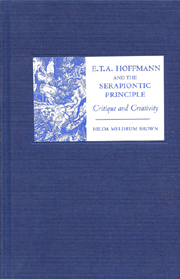Book contents
- Frontmatter
- Contents
- List of Illustrations
- Preface
- Acknowledgments
- List of Abbreviations
- Introduction: Approaches to the Serapiontic Principle
- Part 1
- 1 Overture: Jacques Callot
- 2 Der Einsiedler Serapion: The Formulation of a Principle
- 3 Der Dichter und der Komponist: Text and Music
- 4 Alte und neue Kirchenmusik
- 5 Prinzessin Brambilla: Callot Revisited
- 6 Epilogue: Des Vetters Eckfenster
- Part 2
- Conclusion
- Select Bibliography
- Index
6 - Epilogue: Des Vetters Eckfenster
from Part 1
Published online by Cambridge University Press: 05 February 2013
- Frontmatter
- Contents
- List of Illustrations
- Preface
- Acknowledgments
- List of Abbreviations
- Introduction: Approaches to the Serapiontic Principle
- Part 1
- 1 Overture: Jacques Callot
- 2 Der Einsiedler Serapion: The Formulation of a Principle
- 3 Der Dichter und der Komponist: Text and Music
- 4 Alte und neue Kirchenmusik
- 5 Prinzessin Brambilla: Callot Revisited
- 6 Epilogue: Des Vetters Eckfenster
- Part 2
- Conclusion
- Select Bibliography
- Index
Summary
This very late tale, written in 1822, only a few months before Hoffmann's death, has had a particularly contradictory reception from commentators. Perhaps this is the result of the editorial inconvenience created by a text that was posthumously published and therefore often absent from editions, or else incorporated into the miscellaneous collection of “späte Prosa.” Such a detachment from any fixed moorings may have contributed to, or may have encouraged, readings of the work as a kind of “odd man out,” its late date giving room for speculations about its ground-breaking status as a forerunner of nineteenth-century “realist” prose narrative and thus a clear indication of new beginnings, or a development in Hoffmann's own progress as a writer. However, as we shall see, this masterly tale actually consolidates the theoretical program (or what has been termed “die Poetologie des Schauens”) that Hoffmann had steadily been expounding alongside his literary works ever since the publication of the Fantasiestücke, that program for which the Serapiontic Principle serves as a convenient principal focus. Furthermore, the tale itself can be viewed as decidedly Serapiontic in the way in which it utilizes visual perceptions as a lever by means of which to present the reader with a highly poetic, non-material vision of life, albeit one tinged with sadness and regret. As with my study of Prinzessin Brambilla, where important poetological aspects are to be found embedded in the text itself rather than in the form of a clearly disjoined, authorially or narratorially sanctioned metatext, it will be necessary to examine these theoretical implications in context.
- Type
- Chapter
- Information
- E. T. A. Hoffmann and the Serapiontic PrincipleCritique and Creativity, pp. 106 - 116Publisher: Boydell & BrewerPrint publication year: 2006

